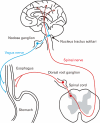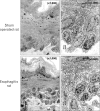Esophageal sensation and esophageal hypersensitivity - overview from bench to bedside
- PMID: 21103417
- PMCID: PMC2978388
- DOI: 10.5056/jnm.2010.16.4.353
Esophageal sensation and esophageal hypersensitivity - overview from bench to bedside
Abstract
Noxious stimuli in the esophagus activate nociceptive receptors on esophageal mucosa, such as transient receptor potential, acid-sensing ion channel and the P2X family, a family of ligand-gated ion channels responsive to ATP, and this generates signals that are transmitted to the central nervous system via either spinal nerves or vagal nerves, resulting in esophageal sensation. Among the noxious stimuli, gastric acid and other gastric contents are clinically most important, causing typical reflux symptoms such as heartburn and regurgitation. A conventional acid penetration theory has been used to explain the mechanism of heartburn, but much recent evidence does not support this theory. Therefore, it may be necessary to approach the causes of heartburn symptoms from a new conceptual framework. Hypersensitivity of the esophagus, like that of other visceral organs, includes peripheral, central and probably psychosocial factor-mediated hypersensitivity, and is known to play crucial roles in the pathoegenesis of nonerosive reflux disease, functional heartburn and non-cardiac chest pain. There also are esophagitis patients who do not perceive typical symptoms. This condition is known as silent gastroesophageal reflux disease. Although the pathogenesis of silent gastroesophageal reflux disease is still not known, hyposensitivity to reflux of acid may possibly explain the condition.
Keywords: Gastroesophageal reflux; Heartburn; Hypersensitivity; Hyposensitivity; Pain receptor.
Conflict of interest statement
Conflicts of interest: None.
Figures


References
-
- Pasricha PJ. Approach to the patient with abdominal pain. In: Yamada T, editor. Textbook of Gastroentrology. 4th ed. Philadelphia: JB Lippincott; 2003. pp. 781–801.
-
- Page AJ, Blackshaw LA. Roles of gastro-oesophageal afferents in the mechanisms and symptoms of reflux disease. Handb Exp Pharmacol. 2009;194:227–257. - PubMed
-
- Knowles CH, Aziz Q. Basic and clinical aspects of gastrointestinal pain. Pain. 2009;141:191–209. - PubMed
-
- Grundy D, Al-Chaer ED, Aziz Q, et al. Fundamentals of neurogastroenterology: basic science. Gastroenterology. 2006;130:1391–1411. - PubMed
-
- Ozaki N, Gebhart GF. Characterization of mechanosensitive splanchnic nerve afferent fibers innervating the rat stomach. Am J Physiol Gastrointest Liver Physiol. 2001;281:G1449–G1459. - PubMed
LinkOut - more resources
Full Text Sources
Other Literature Sources

